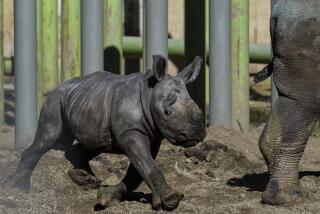COLUMN ONE : Zimbabwe Is Losing Rhino War : The African nation, once a stronghold for the beast, has spent a decade trying to foil poachers who covet its horns. But even the chief of protection calls his efforts ‘a spectacular failure.’
- Share via
SINAMATELLA, Zimbabwe — Holding a radio directional antenna aloft, Stewart Towindo turns slowly in a circle atop a rocky ridge. He listens carefully in his earphones for the sonar-like beeps that mean his prey is near.
“Over there,” the ecologist says, pointing at a distant hill. His tracker and guard, Million Sibanda, shoulders an AK-47 assault rifle and leads the way.
For more than an hour, they hike down rugged gulches and through an arid expanse of brown acacia and thorny scrub. They spot the tracks of zebras, giraffes, impalas and hyenas. They surprise a herd of horned kudu, which leap away silently into the bush.
Loud crunching and crashing suddenly fill the air. “Elephants,” Towindo explains. The giant tuskers flap their ears to keep cool as they eat. To reach leaves, they yank down branches or simply push over trees.
Walking on, Towindo repeatedly checks his radio signal to adjust course. Each time, Sibanda sifts sandy soil through his fingers to check the breeze. He wants to stay downwind.
Finally, both men stop and smile. A black rhinoceros stands 20 yards away, her armored skin half hidden in the brush. The radio transmitter hangs from her neck on a thick nylon-and-leather collar. A huge calf suddenly lurches beside her. Their ears are erect, and the dim-sighted animals peer nervously toward the intruders.
Soon the massive two-horned beasts resume munching noisily on a nearby bush. “The chewing sound is a giveaway,” Towindo whispers. “That’s what poachers listen for.”
This is the front line of Africa’s worst wildlife war, the losing battle to save the once-plentiful black rhinoceros from virtual extinction in the wild. And by all accounts, Diceros bicornis may be doomed.
Here in Zimbabwe, ruthless poachers armed with AK-47s have all but annihilated the last major stronghold of black rhinos. The country’s black rhino population, long the world’s largest, has plummeted from an estimated 2,500 in 1991 to fewer than 300. The once-teeming Zambezi Valley is empty of rhinos.
Poachers have relentlessly blasted the animals and hacked off their horns for sale to the Far East. They’ve succeeded despite radio collars, dehorning of hundreds of rhinos, use of heavily protected animal sanctuaries and a shoot-to-kill policy that has left 178 suspected poachers and four game wardens dead.
Even Glen Tatham, who launched Zimbabwe’s rhino protection program a decade ago and runs it today, calls his efforts “a spectacular failure.”
The chief wildlife warden points to gory photos of mutilated rhinos that line his office wall. “It’s been a terrible battle,” he says.
Although millions of dollars have been donated from abroad, Tatham insists he has never had enough money, equipment or political backing to fight poachers. Corruption has never been far off. Police, game wardens and even a member of Zimbabwe’s Parliament have been convicted of killing rhinos or trading in the horn.
Money is the motive. Rhino horn is more valuable than gold after a price markup similar to that for cocaine. The poacher usually is paid $350 per horn, which may weigh 20 pounds. The same horn is worth $1,000 a pound to middlemen in Lusaka, capital of neighboring Zambia, where most of the gangs are based.
But the price jumps to $13,600 a pound after the horn--made of material similar to human fingernails--is smuggled to Taiwan, South Korea and other Asian nations where traditional healers crush it for potions used to treat fevers and other maladies. A market also thrives in Yemen, where the horn is prized for ceremonial dagger handles.
Poaching isn’t unique here, of course. Zimbabwe’s sad slaughter mirrors what already has happened across most of Africa. Experts say that fewer than 2,500 black rhinos survive--down from at least 65,000 believed to have roamed the continent in 1970. It was then Africa’s most abundant rhino species.
“It’s been a catastrophic decline,” says Clive Walker, head of the Rhino and Elephant Foundation, during a recent two-day conference of rhino experts outside Pretoria, South Africa.
“We’re at the end of the crisis,” agrees Michael Knight, a rhino authority with South Africa’s Natal Parks Board. “This is our very last chance.”
Although poaching from neighboring Mozambique has increased, South Africa is the only country where a rhino population has grown substantially and where several dozen rhinos are legally shot by trophy hunters each year. Indeed, it is a conservation success story.
In 1920, only a dozen southern white, or square-lipped rhinos, were known to have survived widespread overhunting. After intensive protection and breeding efforts, 5,300 white rhinos live in South African parks and on private land. Hundreds more have been sent to zoos and safari parks around the world.
As a result, South Africa will propose removing the white rhino from the most endangered list at the biannual meeting of the Convention on International Trade in Endangered Species in Ft. Lauderdale, Fla., from Nov. 7 to 18. CITES, as it is known, has banned all trade in products from the two African (black and white) and three Asian (Sumatran, Javan and Indian) rhino species since 1977.
Arguing that sustainable use is now possible, South Africa will call for shifting the white rhino to the threatened category. If approved, regulated trade in white rhino hides and ultimately horn could resume. Zimbabwe will support the move, arguing that the ban clearly hasn’t worked.
“Rhino horn, as far as we’re concerned, should be traded,” says Michael Kock, chief veterinarian with Zimbabwe’s department of national parks and wildlife management. “This is one example of a ban that has failed completely. . . . Why practice a policy that has failed for so many years?”
There is another reason. Kock’s office sits atop a strongroom holding an estimated $4 million worth of rhino horn. Officials here say the money is desperately needed for conservation and law enforcement.
Much of the trove is from dehorning. Using helicopters, tranquilizers and saws, veterinarians cut horns off almost 500 rhinos in 1992 in hopes of removing the reason for poaching. But the process is expensive--$1,000 per animal--and must be repeated regularly, since a horn grows several inches a year.
Experts argue bitterly about whether removing the horn helps or whether it makes the animal more vulnerable.
But Dick Pitman, who heads the Zambezi Society, a prominent conservation group in the Zimbabwean capital, Harare, says there is no alternative. “A rhino without a horn may or may not get shot. But a rhino with a horn certainly will.”
Still, others fear that sinister new market forces are at work: Organized poachers may be deliberately aiming to kill the last rhino. “These guys are sitting on stockpiles that will rocket in price if the rhino goes extinct,” worries zoologist Sky Alibhai, who heads a rhino census project in Zimbabwe.
More than half Zimbabwe’s rhinos are in private parks and conservancies. Most of the rest have been herded into four new “intensive protection zones.” In theory, the army, police, air force and intelligence agencies are helping to coordinate anti-poaching efforts.
“We see these IPZs as the last stronghold,” explains Tatham, the chief warden.
The greatest number of surviving black rhinos are here in Sinamatella, 656 square miles of parched grassland and rugged hills deep inside Hwange park. The warden is Norman English, a lanky 34-year-old with a lopsided grin.
His war room has a table covered with crackling radios. A wall map, protected by a faded curtain, is marked with bright red arrows for poacher routes and with grim black circles for dead rhinos. Six soldiers play cards outside beside 10 bleached rhino skulls. All the skulls are missing horns.
Opening the map, English says his zone contains “anywhere from 25 to 65 rhinos,” down from hundreds a decade ago. “In 1982, we used to use rhino horns as doorstops and leave them outside at night,” he recalls. “That shows how valueless they were.”
No longer. English has too few animals to study effective management and protection techniques. He deploys 38 armed scouts on weeklong patrols but says he needs twice as many just to track the rhino, a solitary creature with a notoriously nasty attitude.
Chasing poachers is another matter. The last known poaching here was in March. One suspect was killed, another wounded and a third escaped after a long manhunt. Five sets of black rhino horns were recovered, all from dehorned animals. But English says shooting poachers isn’t the answer.
“I shot over 30 poachers and lost 104 rhino,” he says of his tenure in a previous post in northwestern Zimbabwe. And the poachers are increasingly sophisticated.
“They’re masters in the bush,” he says, shaking his head. “They’re on a par with any Special Forces in the world. They’ll go without water for two days and walk 100 kilometers (62 miles) in a day. And they disappear. They leave no tracks. They start anti-tracking. They’re unreal.”
Some poachers tie cloth on their shoes to hide their tracks, or walk backward to confuse pursuers. They walk on logs and rocks and build no fires. The last group were caught only when they were heard chopping a tree for honey.
For now, all is quiet in the rhino war. English says he doesn’t know if that’s good news or bad.
“We don’t know if it’s because of the increased law enforcement,” he says moodily, staring at his map. “Or, basically, because there are almost no rhino left.”
More to Read
Sign up for Essential California
The most important California stories and recommendations in your inbox every morning.
You may occasionally receive promotional content from the Los Angeles Times.














